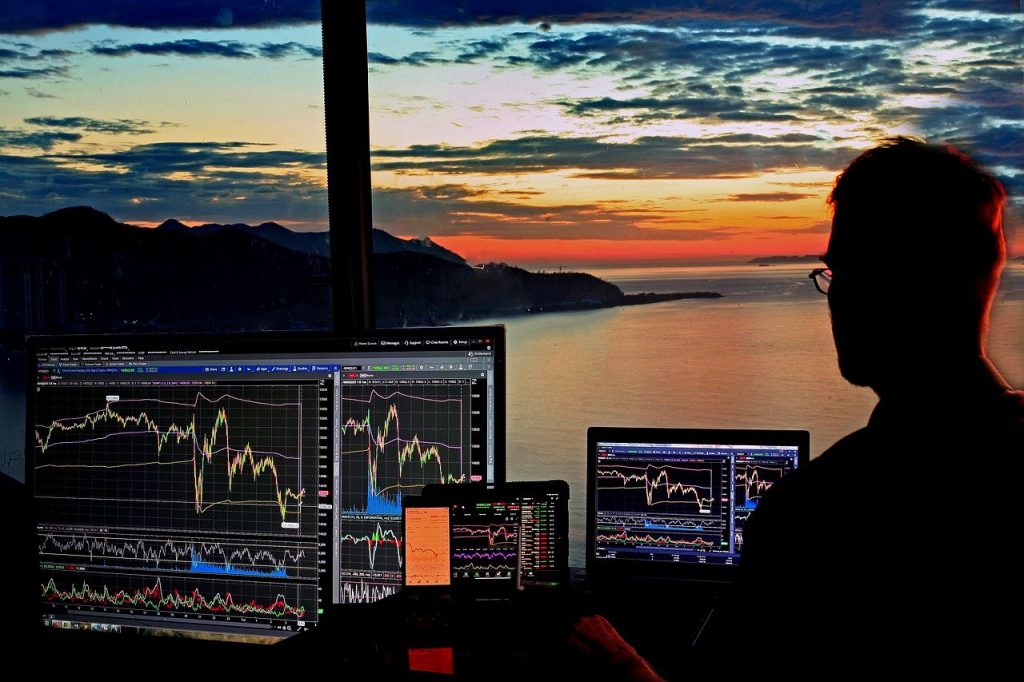Advancements in technology have ensured anyone with a working internet connection can start day trading from their laptop or PC. But whilst it might be possible, how easy is it and how do you go about doing it? This guide will look at the benefits of day trading, what and where people are trading, plus some invaluable tips to getting started.
Is Day Trading Long Term Possible?
The first thing to note is that successful day trading is certainly possible, but it’s not easy or less work than any other vocation that requires time, study and discipline.
Whether this is a route that you want to try or not, knowing what is required is a useful tool for traders at any level.

Beware – there are many out there who claim to make a fortune on day trading, but usually, these people are trying to sell you something. Don’t believe the hype or that there is such a thing as “easy money”.
There are ways to make it simpler – for example, cutting living expenses or operating ‘side gigs’ can ensure multiple streams of income, if the worst happens.
Risks
Despite the obvious allures of taking charge of your investing, comments about day trading full time also highlight some downsides.
The most common challenges of day trading for a living include:
- Solitary lifestyle – Although having colleagues can be frustrating at times, it can also provide a sense of comfort. Day trading can be a lonely profession, so consider this before pursuing it.
- Inconsistent salary – Day traders can experience huge fluctuations in their income. One day they may earn $3,000, and the next day they may lose $2,500 or more. This inconsistency makes it difficult to rely on a stable salary. Additionally, taking a day off means no pay.
- Career progression – Day trading is a results-based industry, meaning that career progression is limited to one’s performance. Returning to the traditional business world may also prove challenging, as some forums suggest that day traders become less employable over time.
- The battle against bots – Algorithms, automated systems, and bots account for 60% of all market volume. While humans still have a place in the market, day traders must continually adapt to maintain an edge.
What Are Popular Markets for Day Trading?
Choosing which markets or assets to trade is a crucial decision for day traders. The following markets are popular among those who day trade for a living:
The volatility and volume in the chosen market will greatly impact a day trader’s success, whether they are trading penny stocks or currencies.
The cryptocurrency market, for example, is highly volatile, which increases opportunities – but also raises risk significantly.
Whereas, day trading stocks may be more challenging, as it is already a saturated market. In addition, a relatively high amount of initial capital is required and losses could be more financially devastating.
Again, day trading commodities, futures or e-minis for a living will present their own challenges, pointing to the need for effective research and understanding.
Regional Differences
Different locations create different issues for would-be traders to navigate.
India, Indonesia or South Africa, for example, not only offer volatile markets for trading, but you also have a very low cost of living, making it more feasible. Access to markets with more volume is challenging, and there may also be time-zone issues too.
Day trading full time in the UK, US, Canada, or Singapore still offers plenty of opportunities, but you have an abundance of competition to contend with, plus high costs of living.
You won’t be short of volatility or volume, but you’ll need to calculate how much you will need to make on average each week or month to be financially comfortable.
‘How To’ Guide
Making a living trading is no easy feat as you’ll have a number of potentially expensive obstacles to overcome. Below, we’ve collated some top tips to help keep you firmly in the black.
Setup
The question on many aspiring traders’ lips is, how to start day trading full stop.
Firstly, you need just a few fundamentals. Get those fundamentals right and you’ll be in the strongest position to start.
- Hardware – You need at least a mid-range computer and internet connection. Any hardware or internet crashes could cost you dearly. Many suggest having two monitors up and running, for convenience as well as emergencies.
- Broker – Make sure you pick a broker that suits your needs. They need to offer competitive prices, reliable customer support, and an easy to navigate platform.
- Strategy – You need a strategy that suits your trading style. It may rely on charts, patterns, and technical indicators – so ensure you have access to these. In addition, your strategy should enable you to manage risk on high volume, low-value trades.
Trading Office
Location is an important topic. Will you have an office at home or try and trade remotely in a variety of locations on a laptop?
You may have seen the images of a lone trader sitting behind 6 or even 9 monitors keeping track of all sorts of data – but is it necessary? One alternative to trying to dedicate some space at home to trade is to use rented desk space.

There is also a service that takes things a step further. ETrading HQ offers leased desk and office space, but also day trading data and collaboration.
Like-minded traders can exchange ideas and strategies face to face.
The concept is booming in both London and New York and may make day trading for a living much more viable for those concerned about markets data, solitude and office space.
Capital
Another question traders may be asking is: ‘how much capital do you need?’ The one requirement of day trading from home is capital. Roll back the dice a few years and you needed a minimum of $25,000 to start day trading in the US. Not only that, but you always had to maintain at least that amount in your account.
These tough regulations meant that for the majority of people, trading for a living was simply not financially feasible. However, the globalisation of the financial industry has allowed numerous platforms to develop outside of strict regulation. Today, you can start with as little as $1,000 in your account.
How much capital you will need will depend on what it is you want to start trading.
Education
If you want the best chances of succeeding at day trading, you need to utilise a wide range of resources. Fortunately, you can now find free, educational tools with just a few clicks of the mouse. Some of the most effective resources worth considering are:
- Forums – ideal for those looking to start making a living by day trading stocks, futures, forex, and cryptocurrencies.
- Ebooks – e.g. ‘The New Trading For A Living ebook’, by Alexander Elder (hassle-free download)
- Books – see our list of good reads, including easily accessible Google books.
- Tutorial videos
- Study guides
- Audiobooks
- Podcasts
- PDFs
- Blogs
You’ll find first-hand advice from experienced traders on forums, blogs, and chatrooms.
You can also benefit from detailed strategy examples from books, PDFs, and tutorial videos – many of which can be found on e-commerce sites such as Amazon and Flipkart. A lot of the ‘day trading for a living’ ebooks, epubs, and PDFs are available for free downloads too and can be accessed via Kindle.
If you’re looking for specific guidance on how to make a living day trading forex, consider the forex page. Alternatively, see the stocks page if you’re interested in trading stocks from home for a living.
Risk Management
If you’re looking at how to do day trading, one of the essential components is how you manage risk.
As Larry Hite rightly asserted, “Throughout my financial career, I have continually witnessed examples of other people that I have known being ruined by a failure to respect risk. If you don’t take a hard look at risk, it will take you.”
You need a system that ensures you have enough to make moves, whilst retaining enough capital that you don’t have to stop.
A good system revolves around stop-losses and take-profits. These allow you to plan ahead and prevent heightened emotions from taking control of decisions.
- Stop-loss – This is simply the price at which you will sell a stock and take the loss. It will eradicate you holding on in that hope that it will come back.
- Take-profit – This is the point at which you will sell a stock and take the profit.
- This will help you retain that profit, by enabling you to sell before a period of consolidation kicks in.
Psychology
If you’re trading, consistent and stable profits are the goal – but these are no means guaranteed – you will require a consistently disciplined mind.As Victor Sperandeo highlighted, “The key to success is emotional discipline.If intelligence were the key, there would be a lot more people making money trading.”
It may sound straightforward now, but when you’ve got $2,500 on the line and you’ve been staring intently and tensely at the screen for the last six hours, keeping fear at bay isn’t so easy.
An effective way to limit your emotional liability is to employ as much technical help as possible.
Keeping your emotions in check will take practice, a lot of mistakes and then even more mistakes.However, a neat trick that helps many traders is to focus on the trade, not the money.
Take it from experienced trader Alexander Elder, “The goal of a successful trader is to make the best trades.Money is secondary.”
Final Thoughts On Day Trading For A Living
The number of people day trading for a living since 2014 has surged.
But is it realistic?
The answer depends entirely on your ambition and commitment.It won’t be an easy ride.But, if it suits your working style, you choose the right market and you utilise the tips mentioned, then you could be one of the few that triumph.
FAQ
How Can I Start Day Trading?
To start day trading full time, you will need to consider the setup you will use to carry out your trading practices.
This includes reliable technology and hardware, plus a suitable workspace (whether that’s at home or elsewhere). Utilising various resources, and knowing where to find them, will also be key to your day trading journey.
Is Day Trading For A Living Easy?
Day trading for a living is by no means easy, especially for those just starting out. The risks are huge, and there are absolutely no guarantees. It is a fact that more people lose money trading than make a profit. Consider that before getting involved.
How Much Capital Do You Need To Start Day Trading For A Living?
How much capital you need will ultimately depend on where and what you are trading. The cost of living in countries such as the UK, US and Singapore, for example, is much higher than in other nations, so you will need to factor in what costs you will need to cover.
Further Reading
